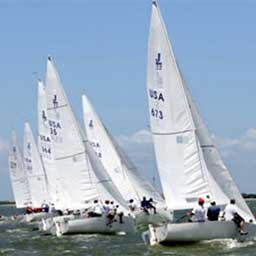US Sailing Sports Medicine Committee
US Sailing has been collecting and reviewing data and information on severe brain injuries in competitive and recreational sailing. Similar to modern American football and other sports at risk for impact to the head, this topic has been a growing concern for sailing that requires an educated approach. The routine use of helmets in sailing has been in question for years and now, due to the increasing frequency of such injuries, there has been a building movement to provide more education and resources on helmet use.
There are two subjective categories to consider regarding head injuries:
Traumatic Brain Injury
Traumatic Brain Injury is a more severe condition, beyond what would be considered a concussion. As a tragic example, Andrew “Bart” Simpson died of severe head and neck injuries in the wreckage of Team Artemis’ capsized 72-foot catamaran in May of 2013. Prior to that, the first America’s Cup training death was Martin Wizner, who was a Spanish sailor struck in the head by a piece of equipment that broke loose while sailing with the Spanish Challenge in Valencia, Spain in 1999 (1). The CCA Fleet Surgeon lists at least nine deaths in racing venues caused by blunt trauma to the head during accidental jibes (2). These and increasingly numerous other reports are reason enough to consider the usage of helmets in competitive racing programs for crew positions that are at risk for blows to the head. Helmet use for sailors who are new to the sport and do not yet have the awareness of the rigging and equipment should also be encouraged.
Concussion
Concussion (or closed head injuries) diagnosis is on the rise and the identification and treatment is evolving. They are caused by changes in the brain (white matter) when the skull is suddenly rotated due to an acceleration/deceleration effect within the skull, and can occur in small boat and dinghy racing where aggressive jibing and tacking is taught and widely practiced. They can even occur from accidental and unexpected strikes to the head in calm cruising conditions. Concussions in American football and boxing have been shown to be associated with delayed onset dementia, and the type of changes seen within the brain associated with symptoms of concussion are similar to the distribution of changes seen in brains of Alzheimer patients (3). The permanent damage resulting from one concussion is not known and cannot be assumed to be negligible. Concussions are being taken seriously in football, soccer, and hockey, and numerous other sports. They should be taken seriously in scholastic and collegiate sailing.
A word of caution now needs to be clear to all persons who consider using helmets while sailing. There is no data to confirm that helmets will prevent concussions. Helmets have been shown to reduce the incidence and severity of facial and skull fractures, contusions and lacerations, but not concussions. (4, 5) Concussions seem to occur more easily in pre-teen and teens. We also need to be aware that wearing a helmet makes the head a “larger” target and could possibly lead to more head strikes.
Therefore, it is the position of the Sports Medicine Committee of US Sailing that helmets should be considered and encouraged but not mandated for aggressive competitive sailing, crew positions at increased risk for strikes to the head, and sailors who are learning the sport and thus unfamiliar with the position and movement of rigging and equipment.
In the rare case that a concussion or head injury occurs, treatment thereof and the evaluation for a return to activity should be conducted by a trained specialist.
US Sailing strives to maintain the freedom of open competition and participation at all levels of the sport while making recommendations that follow the currently available data regarding safe practices. Awareness of injury risk prevention and general safety planning for all sailing events has been and will remain a priority for this organization. In the future, we will revise our recommendations as needed as the data evolves and distribute these to our members and the world of sailing in as timely a fashion as possible. Communication is paramount regarding collection of information in all sailing injuries and we will continue to improve our ability to communicate and collect this data through the assistance of our volunteers and partners.
References:
(1) – Communiqué from Spanish Challenge to AmericaOne skipper Paul Cayard in Jan. 1999.
(2) – Fleet Surgeon’s section, Cruising Club of America website
(3) – Symptomatic white matter changes in mild traumatic brain injury resemble pathologic features of early Alzheimer dementia: Radiology, 2013, October, 269:249-257
Fakhran S, Yaeger K, Alhilali L
(4) – Br J Sports Med. 2013 Jan;47(1):15-26. doi: 10.1136/bjsports-2012-091941. American Medical Society for Sports Medicine position statement: concussion in sport.
Harmon KG1, Drezner JA, Gammons M, Guskiewicz KM, Halstead M, Herring SA, Kutcher JS, Pana A, Putukian M, Roberts WO.
(5) – Neurosurgery. 2014 Oct;75 Suppl 4:S136-48. doi: 10.1227/NEU.0000000000000496.
Current and future concepts in helmet and sports injury prevention.
Hoshizaki TB1, Post A, Oeur RA, Brien SE.











